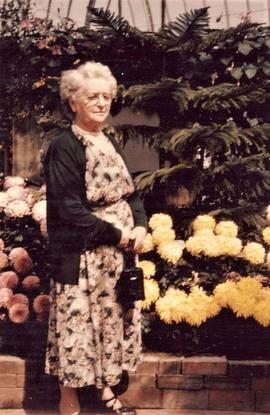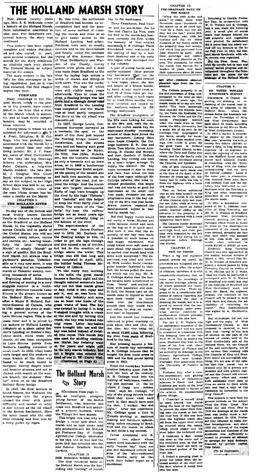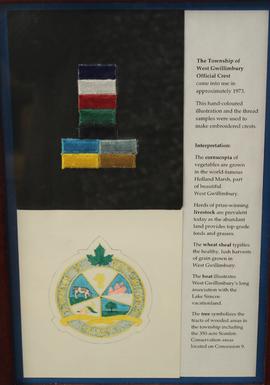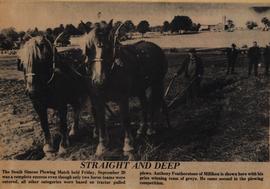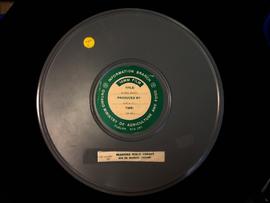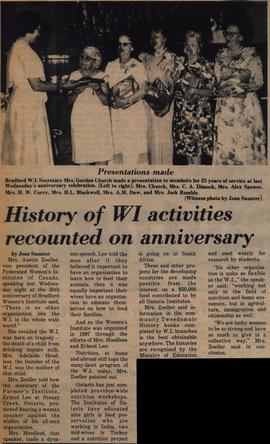Description : The Holland Marsh Story
Now almost twenty years ago, Mrs. S.S. McKenzie wrote a history of the Holland Marsh, from information assembled to that date. For Bradford's centennial history, the story was continued.
This history has been copied complete and widely distributed and also copied, in part, upon several occasions, but the search for the story continues, as students each year choose The Holland Marsh as subject material for essays.
The story written in the late '40's for this newspaper is being republished, just as it was first recorded. The first chapter begins this week.
Forward
Many interested in the Holland Marsh, either in the past, or in the present, have contributed in the hope that a story of the Marsh which is authentic, and at least fairly comprehensive, may be recorded in these columns.
Among those to whom we are indebted for information are T. A. Pratt, Islington; B. B. Collings, who has probably been associated with the Marsh for a longer period than any other living person; Mr. J. F. Hambly, reeve of West Gwillimbury at the time the big Drainage Scheme was undertaken; Mrs. Peter Catania, a long-time Marsh resident; the late Mrs. M. J. Douglas; Mrs. Glenn Boyd, whose prize-winning essay on the subject in her High School days was lent to us; and Mrs. Dave Watson, widow of the man whose dream has become a reality on the Marsh.
Chapter I.
The Holland River Marsh
To-day one of the richest and most widely known Garden Tracts in Ontario is that known as the Bradford or the Holland Marsh. In the vegetable stores across Canada and in parts of the United States, you will see potatoes, celery, lettuce, onions and carrots etc., bearing boastfully the label "Bradford Marsh" or simply "Marsh" as a sign of quality. But the Bradford Marsh not always was a gardener's paradise. Unbelievable as it may now seem, it was once nothing but an impassable marsh or Tamarac swamp, covering thousands of acres.
Beginning about Schomberg and flowing or moving in a very sluggish manner in a north-easterly direction towards Lake Simcoe is the stream known as the Holland River, so named after a Major S. Holland, Surveyor General of Canada, who in 1791 visited the river in making a general survey of the Lake Simcoe region. This is the main river and it is joined by an eastern or Holland landing tributary at a place called Soldier's Landing or Soldier's Bay, about seven miles from the mouth. At one time, navigation to Lake Simcoe points from Soldier's Landing consisted of small craft. In 1850, when boats were larger and the western or main branch of the river was found to be much easier to navigate, having deeper water and broader streams and not so choked with marsh at the eastern branch, the steamer "Beaver" went on to the Bradford Holland River bridge.
In 1819, the first settlers in South Simcoe, the Wallaces, the Armstrongs and the Algeos crossed the river with great difficulty and landed at what is now known as the old wharf in the Scotch Settlement. Here for some years was the only river crossing and that was by a ferry pulled by ropes.
By this time, the settlement of Bradford had become an accomplished fact and the question of some method of crossing the marsh and river so as to give easier access to the Holland Landing had arisen. Petitions were sent to county councils and the Government and finally, under the constant urging of Wm. Armson, Reeve of West Gwillimbury and Warden of the County, money grants were given and a road was made from Bradford to the river by laying logs across a width of marsh and filling in with earth. This was the corduroy road, the logs of which were still visible many years afterwards. Then to cross the river, a floating bridge was laid down and a through direct road from Bradford to the Landing was completed and the Marsh was at least partly conquered. The ferry at the old wharf was discontinued.
In 1837, George Lount, Government Surveyor, surveyed as a townsite, the spot on the south of the river just beyond the floating bridge, known as Amsterdam, and the streets were laid out bearing such good Holland names as De Ryder, De Witt, Van Dyke, Rubens, etc., but the townsite remained as only a townsite and no town arose, so in 1869 a lumberman named Thompson Smith acquired the patent of the unused site and built two sawmills, one on each side of the road, just beyond the bridge. And the marsh was still largely unconquered. Rafts of logs were brought up the river by the tugs "Victoria" and "Isabella" and this helped to keep the river fairly clear of weeds. The wreck of the "Isabella" lay near the railway bridge not so many years ago and is now probably lying on the bottom of the river.
The superintendent of the sawmills was James Durham and 1870, Mr. Durham cut the floating bridge in two, in order to get the logs through and this caused a lot of trouble, but led to the erection of a bridge above the water. This bridge was 420 feet long and was completed in April, 1871, the builder being Thomas McConkey of Gilford.
To the many men working in the mills, the great marsh became a familiar sight and the thought entered someone's head why not cut that marsh grass or hay, twist it into ropes and sell it, and so was born the marsh hay industry and some use at least was made of the great waste of land. The hay was twisted by laying it in long V-shaped troughs with a crank at the end and by turning this crank, the hay was twisted into long ropes. Later hay-balers were brought into use and the hay was baled instead of twisted into ropes. This marsh hay was used for stuffing mattresses. Marsh hay twisting went on for years and might still be the only marsh industry, had not a bright idea entered the head of one D. W. (Dave) Watson, an intelligent, energetic young farmer of the Scotch Settlement, who, however, had come into Bradford and acquired a grocery business, where the Village Inn now stands.
This bright idea was, why not dredge a canal and drain the marsh and so turn waste land into productive soil. Mr. Watson got Professor Day of Guelph Agricultural College interested in his idea and so was laid the germ that has sprouted into the now famous Bradford Marsh Gardens.
Chapter II.
The Horses Wore Boots
The first industrial boom on the Holland Marsh was the harvesting and "curling" of marsh hay to fill mattresses.
Three Frenchmen, Paul Courier and his son-in-law, Joe Le Duc and Charlie La Vince, were the first in the marsh-hay business, certainly the first within the memory of that veteran marshman B. B. Collings. These Frenchmen were instructed in the curling of hay by a man from Montreal and in the early 80's began what developed into a big industry.
A pair of strong hands and a scythe equipped these pioneer hay harvesters. They cut the hay with a scythe and twisted it into ropes, about the size and length of a broom handle, by hand. A man could twist about 20 of these ropes per day, and, after curling in such ropes for at least three months, they were uncurled and teased by the mattress makers to fill springy mattresses.
The Bradford youngsters of the 80's were looking for work in the 90's, and, with the demand for curled marsh hay for mattresses steadily increasing, several of these boys joined the hay harvesters. Among them were Louis Chapelle, the Collings brothers, B.B, Dan and Ernie, Tom Morris, James Armstrong, B. Caesar and Murphy and Josh Goodwin of Holland Landing. Hay cutting was done on a much larger acreage. To supply the demand the hay ropes increased in size to three and then four times the size of the first ropes, although Mr. Collings informs, like most increased production, this larger curl was not nearly so good for mattresses as the small curl first made. Probably the most progressive step in the hay cutting of the '90's was that horse-drawn mowers replaced hand-powered scythe in harvesting marsh hay.
But the boggy marsh would not carry a horse. Horses and cattle became mired and sank in the bog as if in quick sand. And here it was that the ingenuity of the hay men made it possible to work horses on that boggy marshland. Men could travel over soft snow on snow shoes, why couldn't horses be carried over marsh land with some such equipment? The experiment was tried and worked. With wooden boots (rectangular boards) fastened to their feet, the horses pulled the mowers which cut the hay. Mr. B. B. Collings states that the horses became quite accustomed to these "boots" and walked on them with assurance and ease. In fact, the horses used on the marsh came to depend so much upon their "boots" to carry them over the treacherous ground that they would balk and refuse to step on marshland until so equipped.
And the marsh hay business continued to grow, reaching its peak about 1914 and 1915. By that time, hay was being cut on about 12,000 acres, following the river from south of Bradford to the lake.
Hay pressing became a feature of marsh hay harvesting. B. B. Collings informs that he bought his first horse press in 1904 and his first power bailing press in 1912.
From the marsh hay business another industry arose. Just before the turn of the century, B. B. Collings went into the making of mattresses, conducting this business on the lot where J. Gapp now resides. "And," says Mr. Collings, "if any of the young fellows to-day think they know what hard work is, they should have seen me then. I worked day and night." After this experience, Mr. Collings spent a time in Toronto working at mattress making and furniture upholstering, before returning to Bradford and the marsh, in which he still holds a big interest.
James Armstrong and B. Caesar, two others whose names were associated with the early "marsh hay" days, are also still marshland owners, and sons of the aforementioned Thos. Morris, carry on the work their father began as a marshman.
Chapter III.
Pre-Drainage Days On The Marsh
"When the wild ducks and gees," of which there were thousands upon thousands on the marsh up to 20 years ago, "rose as a flock into the air, they hid the sun," states Mrs. Peter Catania, who, with her husband and the six eldest members of her family came to the property they now occupy, and which they purchased from John Maurino in April, 1918. Deer, partridge and rabbits were also very plentiful on the area. The pheasants, for which the marsh was famous for a number of years, only made their appearance about 20 years ago after residents obtained pheasant eggs from the Government.
The Catania property is on the 2nd concession of King, and, compared to the road on that concession 30 years ago, the marsh roads of to-day are wonderful. The little settlement then included the Sweezie family, the Taits, the Speziallis, the Simones, the Cooks and the Catanias. Practically isolated when the roads were at their worst, the little community had a social life of its own. In the evenings they congregated in one home, usually for music, and it is to those musical evenings that credit is given for the good music in Holland Landing United Church to-day, where the Taits and Cooks now reside, and for the family orchestras, which developed among the Catanias and Speziallis.
One of Mrs. Catania's memories of those early roads was at the time of the death of Mrs. Sweezie 22 years ago. Mr. Kilkenny had to make the trip in from the highway with a horse and wagon.
That an Indian settlement was at one time located on the edge of the marsh is the belief of Mrs. Catania. Only last year, her son John, while at work on the property, found an Indian arrow. Another oddity at the entrance to the property is a large stone marked with a cross apparently hand hewn.
The Catania family developed a market-garden business on semi-high land, and their gardens were inspected by the late Prof. W. H. Day during his investigations before drainage was started.
Chapter IV.
Men of Vision
When a big and expensive project proves its worth, its promoters are eulogized and its opponents are often the subject of criticism, therefore, it is with considerable hesitancy that we enter upon the recordings of the marsh drainage scheme, all of which predated our knowledge of this area. There appears to be a considerable difference of opinion regarding just who conceived the idea of draining the marsh, but it is a agreed by several that the success of drainage under somewhat similar conditions in southwestern Ontario probably gave birth to the idea here.
The late D. W. Watson was an enthusiastic supporter of the drainage project and his name is mentioned in connection with the bringing here of the late Prof. W. H. Day to inspect the area. Professor Day was, at the time of his first visit, about 1910, Professor of Physics and an authority on drainage in the Ontario Agricultural College, Guelph. Born near Lindsay, Professor Day graduated from the University of Toronto in 1903.
Professor Day, after a careful examination and gaining knowledge of reclamation schemes in Essex and Kent Counties and study of the local conditions, advised in favour of the scheme. He recommended three things:
- Construct a cut-off ditch or canal around the marsh along the base of the highland to prevent the water from flowing onto the marsh or into the old river bed. If this was done then the highland water shut off from the upper river would be diverted along the canals, which would empty into the river below the reclaimed area.
- Construct a dam across the river at the lower end of the reclaimed area, so that the lake water could not back up the enclosed portion of the old river bed.
- Install a pumping plant to pump the water from the enclosed section of the river over the dam, whence it would flow into the lake.
Returning to Guelph, Professor Day, in co-operation with W. D. Watson and E. Collings, had a test made the following year. A small plot of marsh muck was heaped behind the mill property and vegetables were planted. So satisfactory did it prove that the celery carried off top honours at the local Fall Fair. In 1911, the Holland Marsh Syndicate, with other owners, was organized.
But the First Great War, with its terrific toll in men and money, halted progress and development throughout the Dominion and the plans for the drainage of the Holland Marsh were shelved for the war's duration.
Chapter V.
$25 Voted Toward Engineer's Survey
Discussions in Council regarding the draining or reclaiming of the marsh land lying along or adjacent to the Holland River, where this stream forms the boundary between the Townships of King and West Gwillimbury, date back about 30 years, according to minutes in old Minute Books of West Gwillimbury Council.
In 1910 a motion is recorded as passed by the Council of that year "granting the sum of twenty five dollars ($25.00) toward a fund, to help defray the expenses of an engineer, toward the lowering of the water int he Holland River and the marsh land adjacent thereto, in connection with the Township of King, with the distinct understanding that we incur no further liability." Later in the same year, a communication received from Alex Baird was ordered filed and the secretary was instructed to communicate with the Township of King and other municipalities interested in the drainage of the marsh lands.
In 1911, a deputation, composed of Mr. L. Gibbons, councillor of King Township, and Mr. W. D. Watson of Bradford addressed West Gwillimbury Council, pointing out the advantages which would be bound to come to the municipalities concerned if the marsh lands were drained, stressing the fact that land which was assessed at less than $1.00 an acre would, when reclaimed, be worth $40.00 or $50.00 an acre.
Evidently King Township Council was also approached on the matter because minutes of March 4, 1911, record that Mr. W. D. Watson of Bradford presented a motion passed by King Township Council on motion of R. W. Phillips and N. J. Willis, "that the Clerk be instructed to correspond with W. D. Watson of Bradford and notify him that if the Councils of Bradford and West Gwillimbury meet, and have Mr. Baird, the engineer, present, the members of this Council will be pleased to meet with them and discuss the advisability of reclaiming the marsh."
This communication was signed by A. MacMurchy, reeve.
But enthusiasm did not run high and the reply of West Gwillimbury Council to this proposal is reported to have been that "owing to the lack of interest on the part of the owners of marsh land in the West Gwillimbury side of the Holland River, we, the Council of the said municipality, are of the opinion that meeting with the Councils of King and Bradford would not, accomplish anything. We are also of the opinion that this marsh can be drained only by a private capital and this Council will encourage every effort and render such assistance from time to time as seems to them advisable and that a copy of this resolution be forwarded to the King Council."
This appears to have been the general attitude on the subject when the First Great War broke out and from 1914 to 1919 the drainage of the marsh area was pretty much a dormant subject. In 1919, Professor Day returned to make further investigations and about 1922 the interest of the marsh landowners and members of the syndicate was sufficiently aroused to promote an attempt to arrange for such drainage, financed by private capital. This failed.
(To be Continued)

